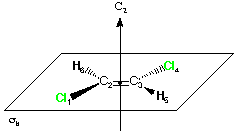#P HF/6-31G(d) opt=(Z-Matrix,tight) test1 HF/6-31G(d) opt trans-1,2-dichloroethylene 0 1 Cl1 C2 1 r2 C3 2 r3 1 a3 Cl4 3 r2 2 a3 1 180.0 H5 3 r5 2 a5 1 0.0 H6 2 r5 3 a5 4 0.0 r2=1.729226 r3=1.310646 r5=1.070566 a3=121.7652 a5=123.8226

This point group contains four symmetry operations:
E the identity operation
C2 a twofold symmetry axis
i a center of inversion
σh a horizontal mirror plane
A simple example for a C2h symmetric molecule is trans
-1,2-dichloroethylene, here in its HF/6-31G(d) optimized structure:
#P HF/6-31G(d) opt=(Z-Matrix,tight) test1 HF/6-31G(d) opt trans-1,2-dichloroethylene 0 1 Cl1 C2 1 r2 C3 2 r3 1 a3 Cl4 3 r2 2 a3 1 180.0 H5 3 r5 2 a5 1 0.0 H6 2 r5 3 a5 4 0.0 r2=1.729226 r3=1.310646 r5=1.070566 a3=121.7652 a5=123.8226 | 
|
last changes: 25.10.2004, HZ questions & comments to: zipse@cup.uni-muenchen.de